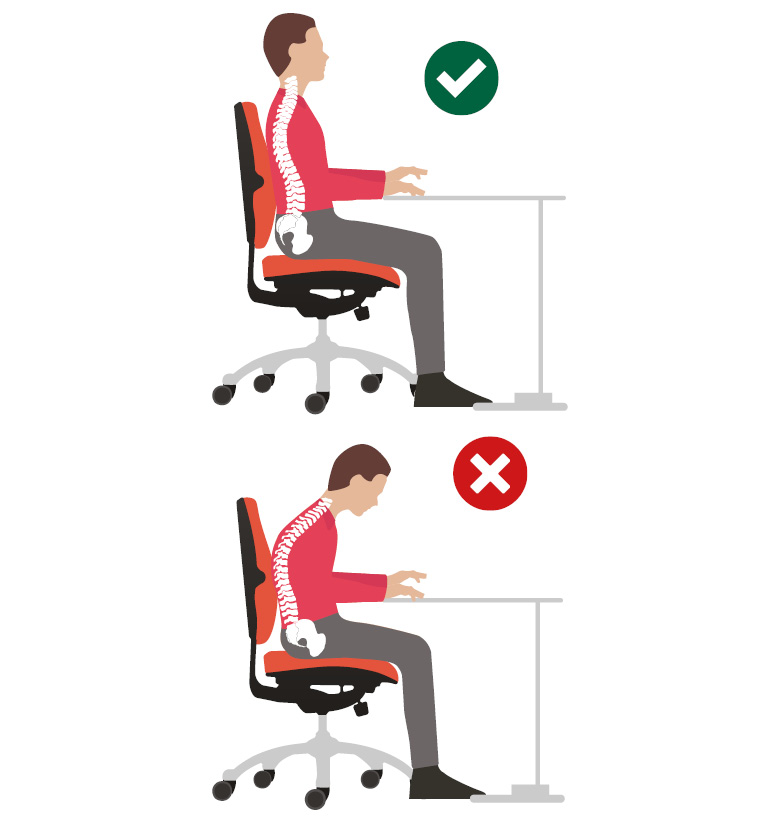Find out how to change your bad posture habits.
Prolonged poor postures can lead to pain in the neck, back, shoulders, arms, legs and feet, as well as referred pain into the head. It can add to stress and fatigue and, in the long term, it can cause serious musculoskeletal disorders. Luckily you can change your bad habits and improve your posture if you follow the right advice.
The first thing to note is that good posture is not about sitting up straight. In fact it is more about being supported in a good position. But there are of course many factors when it comes to good sitting posture.
6 common causes of bad sitting posture






Read on for our guide to the solutions. Follow these tips to improve your postures and remember to take regular breaks and move. Many of us have different aches and pains and different needs, but in general this advice should help.
Perching on the front of the seat
Don't perch on the front of the seat, as this doesn't allow the chair to provide support. It's fatiguing and leads to a slouched position. This results in the loss of the inward curve in the lumbar spine, creating pressure on the wrong part of the lumbar discs.
Solutions
Have your bottom right at the back of the chair and maintain contact between your back and the seat back. Move your chair close to the desk too.
Supportive good posture will be best achieved by a suitably adjusted chair. The lumbar region of the chair, when correctly positioned, will maintain the inward curve of your lumbar spine. In the short term if you have a chair lacking in adjustment, a lumbar support cushion may be helpful, though this will be less effective as a long-term solution.
Sitting at the wrong height
Ideally your hips will be slightly above your knees when you're sitting. If not, you have your chair at the wrong height for you.
Solutions
Adjust your chair height so that your hips are slightly above your knees. Don't let your feet 'dangle' (use a footrest if you need support) and don't cross your legs.
Don't be tempted to raise your legs so your hips are lower than your knees. If your knees are higher than your hips, raise the desk and chair height. Most of the length of your thighs should be well supported by the seat of the chair, with no pressure behind your knees.
You can find out more about how to sit correctly here.
Armrests are at the wrong height
If your chair armrests are too high they can cause raised shoulders and if they're too low, it can cause leaning. Both are bad habits. Your shoulders should be relaxed while you work. Remember also that armrests are for providing support when you're not typing.
Solutions
If the armrests are too high or low, either remove the armrests or get a chair with height-adjustable armrests. Fixed-height armrests often hit the desk edge when the chair is at the correct height, which can make you lean forward or sit on the edge of your seat, away from the backrest. Do avoid these positions.
Armrests are too wide
If your chair armrests are too wide, they'll force you to reach outwards to support the elbows. You should have your elbows relaxed and close to your sides.
Solutions
Adjust your chair's armrests if that's possible – many good ergonomic office chairs have this option. Alternatively, avoid using them or remove them altogether.
Sit back in chair ensuring good back support
Forearms parallel to desk
Space behind knee
Arms relaxed by your side
Screens are too low, high, or far away
The wrong position of the screen or screens (particularly laptops) can create problems with your neck and back.
Solutions
Have your most-used monitor at a height where the top of the screen, not the monitor case, is level with your eyes. And this should be directly in front of you at about arm's length.
Use a monitor arm or put the monitor on a monitor block.
Looking up and down too much when reading
Frequently referring to documents on your desk can require a lot of head movement and potential bending and twisting of your neck. In fact, many posture problems are caused by too much twisting.
Solutions
A good way to reduce this is to use a writing slope or document holder to place your reading material in front of you, at an optimal height and angle.
Balanced head, not leaning forward
Screen approximately arm's length from you
Top of screen about eye level
Feet flat on floor or on a footrest
Plus...
- Don't forget to get up and move every 20 minutes or so. Find recommended workstation exercises here and Move More in '24 resources here.
- Check that your mouse and keyboard positioning help you achieve good posture too.
If you need further help with your workstation positioning to improve your comfort while working, you could book a DSE assessment.






